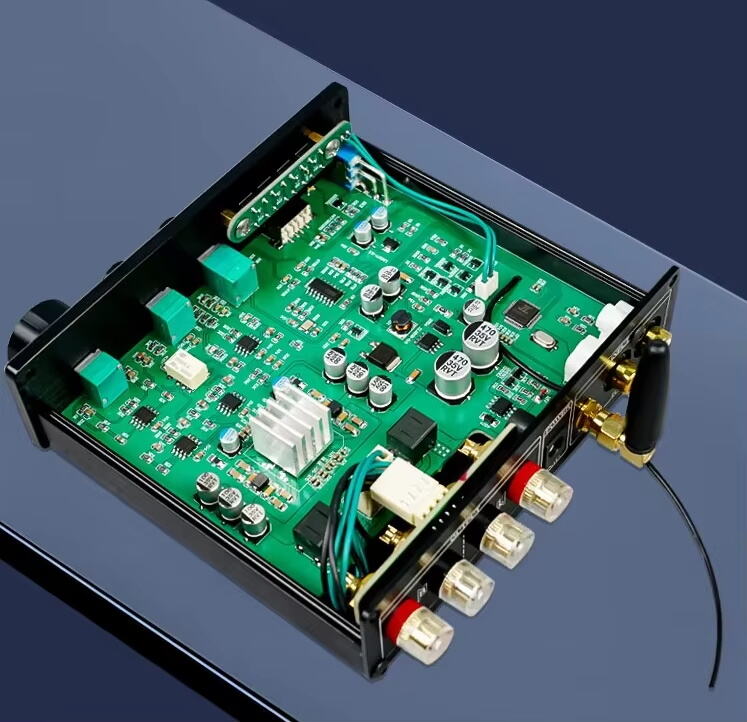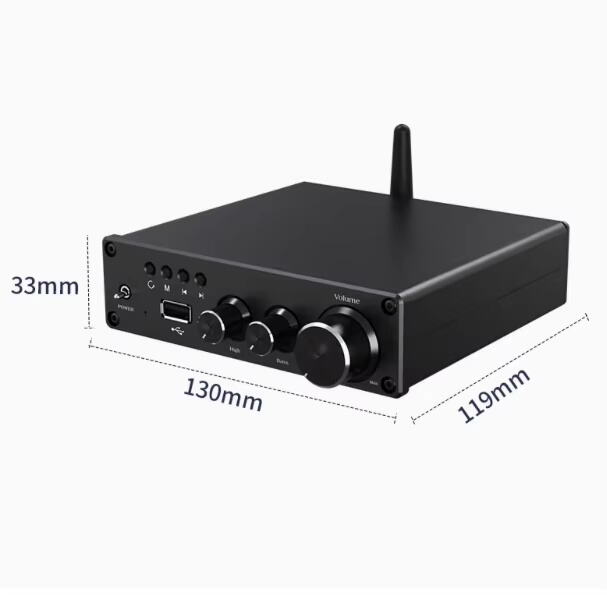Zrozumienie ewolucji wzmacniaczy audio
Świat technologii audio doświadczył wielu innowacji przez lata, a jednym z najważniejszych przełomów jest Wzmacniacz klasy D . Tradycyjne wzmacniacze, takie jak klasy A i AB, dobrze się sprawdzały przez dekady, jednak ich niska wydajność, generowanie ciepła i duże rozmiary stwarzały ograniczenia. Wzmacniacz Wzmacniacz klasy D wprowadził nową epokę w systemach dźwiękowych, łącząc kompaktowość, chłodną pracę i imponującą wydajność.
W przeciwieństwie do konwencjonalnych projektów, rodzaj wzmacniacza przekształca sygnał wejściowy w serię wysokoczęstotliwościowych impulsów zanim zostaną one wysłane do etapu wyjściowego. Metoda modulacji szerokości impulsów pozwala na pracę z minimalnym zużyciem energii, co czyni go znacznie bardziej efektywnym niż jego poprzedniki. Wzmacniacz klasy D na minimalnym zużyciu energii, co czyni go znacznie bardziej efektywnym niż jego poprzedniki.
Dlaczego sprawność ma znaczenie w nowoczesnych systemach audio
Sprawność to nie tylko termin techniczny – bezpośrednio wpływa na wydajność, trwałość i doświadczenie użytkownika. Wzmacniacz Wzmacniacz klasy D może dostarczać potężne wyjście, jednocześnie zużywając mniej energii i generując mniej ciepła. Oznacza to, że urządzenie może być mniejsze, lżejsze i bardziej trwałe.
Dla użytkowników chcących mieć systemy kin domowych, profesjonalne zestawy audio lub systemy dźwiękowe w samochodach, sprawność przekłada się na mniejsze wymagania chłodzenia, dłuższą żywotność komponentów i bardziej stabilną jakość dźwięku. W ten sposób, wzmacniacz Wzmacniacz klasy D stanowi idealny wybór dla nowoczesnych zastosowań, gdzie wydajność i praktyczność muszą współistnieć.
Jak działa wzmacniacz klasy D
Wyjaśnienie modulacji szerokości impulsów
W centrum Wzmacniacz klasy D jest procesem zwanym modulacją szerokości impulsu (PWM). Zamiast ciągłego wzmacniania analogowego przebiegu, wzmacniacz szybko włącza i wyłącza sygnał z bardzo dużą prędkością. Szerokość tych impulsów odpowiada amplitudzie oryginalnego sygnału audio.
Poprzez przekształcenie analogowego wejścia w strumień impulsów przypominający sygnał cyfrowy, Wzmacniacz klasy D znacznie zmniejsza straty energii. Ta metoda jest bardzo skuteczna, ponieważ urządzenia wyjściowe (zazwyczaj tranzystory) są albo w pełni włączone, albo całkowicie wyłączone, co minimalizuje rozpraszanie ciepła.
Filtrowanie i wyjście
Po etapie PWM sygnał musi zostać przekształcony z powrotem w gładki przebieg analogowy, który będzie w stanie napędzać głośniki. Osiąga się to za pomocą filtru dolnoprzepustowego, który usuwa składowe o wysokiej częstotliwości, zachowując jednocześnie oryginalny sygnał audio. Rezultatem jest czyste, nieskrzywione dźwiękowanie przy minimalnych stratach energii.
To sprytne rozwiązanie sprawia, że Wzmacniacz klasy D jest tak skuteczny w łączeniu wysokiej sprawności z wysoką wiernością.

Zaletą stosowania wzmacniacza klasy D
Kompaktowy rozmiar i lekka konstrukcja
Jedną z największych zalet Wzmacniacz klasy D jest jego kompaktowa wielkość. Dzięki mniejszemu wydzielaniu ciepła nie ma potrzeby stosowania dużych radiatorów ani przewymiarowanych obudów. Pozwala to producentom projektować mniejsze i lżejsze systemy, nie rezygnując przy tym z mocy.
Dla głośników przenośnych, audio samochodowego, a nawet profesjonalnego sprzętu sceniczego, zmniejszona waga i gabaryt Wzmacniacz klasy D czyni ją znacznie bardziej wygodną w użyciu.
Chłodna praca i trwałość
Tradycyjne wzmacniacze często pracują w wysokiej temperaturze, co skraca ich żywotność i wymaga stosowania ciężkich systemów chłodzenia. Wzmacniacz klasy D wzmacniacz klasy D, z drugiej strony, pozostaje chłodny nawet podczas długotrwałej pracy. Nie tylko poprawia to trwałość, ale także gwarantuje stabilną pracę w wymagających warunkach.
Niezależnie od tego, czy w studio nagrań, czy w domowym systemie rozrywkowym, chłodna praca wzmacniacza typu Wzmacniacz klasy D czyni go bardziej niezawodnym niż wiele starszych konstrukcji.
Zastosowanie wzmacniaczy klasy D
Do domu Audio i rozrywka
The Wzmacniacz klasy D stał się podstawowym elementem systemów rozrywki domowej. Jego mały rozmiar pozwala na umieszczenie w delikatnych prętach akustycznych i kompaktowych zestawach kin domowych, nie rezygnując przy tym z mocy dźwięku. Użytkownicy cieszą się z bogatego, wypełniającego pomieszczenie dźwięku, a jednocześnie korzystają z niskiego zużycia energii.
Automatyka i systemy przenośne
Systemy audio samochodowe i przenośne głośniki również w dużej mierze polegają na Wzmacniacz klasy D . W tych przypadkach kluczowe znaczenie mają ograniczona przestrzeń i efektywność energetyczna. Dzięki mniejszemu wydzielaniu ciepła i wyższej efektywności baterii wzmacniacze te oferują potężne basy i czyste tony wysokie w kompaktowej obudowie.
Ta wszechstronność pokazuje, dlaczego Wzmacniacz klasy D stał się ulubionym wyborem w różnych branżach.
Dlaczego warto wybrać wzmacniacz klasy D?
Wysoka moc przy niskim zużyciu
Rozważając wybór wzmacniacza, wielu użytkowników zadaje pytanie: jak dużo mocy można uzyskać, nie tracąc przy tym na efektywności? Wzmacniacz klasy D doskonale na nie odpowiada, oferując wysoki poziom mocy przy znacznie mniejszym zużyciu energii niż inne klasy.
Ta wydajność czyni ją odpowiednią zarówno dla dużych systemów dźwiękowych, jak i codziennych produktów konsumenckich. Od profesjonalnych koncertów po nieformalne słuchanie, Wzmacniacz klasy D zapewnia właściwą równowagę.
Współczesne wymagania audio wymagają nowoczesnych rozwiązań
Wymagania audio ewoluowały, a także technologie stojące za nimi. A Wzmacniacz klasy D ofersuje odpowiednie rozwiązanie, dostosowując się do współczesnych oczekiwań związanych z kompaktowością, przyjaznością dla środowiska i wysoką jakością dźwięku.
Dla firm dążących do wyróżnienia się, oferowanie produktów zasilanych przez Wzmacniacze klasy D może podkreślać innowacyjność i projektowanie skierowane do użytkownika.
Powszechne błędy związane z wzmacniaczami klasy D
Czy poświęcają jakość dźwięku?
Niektórzy ludzie błędnie sądzą, że Wzmacniacz klasy D poświęca jakość dźwięku na rzecz wydajności. W rzeczywistości postępy w projektowaniu i technologii filtracji wyeliminowały większość problemów z zniekształceniami. Dziś dobrze zaprojektowany Wzmacniacz klasy D dostarcza jakości dźwięku dorównującej wzmacniaczom tradycyjnym.
Czy są one przeznaczone tylko dla niskobudżetowych PRODUKTY ?
Innym powszechnym błędnym przekonaniem jest to, że Wzmacniacz klasy D jest stosowany wyłącznie w urządzeniach budżetowych. Przeciwnie, wiele wysokiej klasy systemów audio, sprzętu profesjonalnego i premium marek przyjęło tę technologię ze względu na jej niezaprzeczalne zalety.
Często zadawane pytania
Jaka jest główna zaleta wzmacniacza klasy D?
Główną zaletą jest jego wydajność, która umożliwia uzyskanie wysokiej mocy przy niskim zużyciu energii i minimalnym wydzielaniu ciepła.
Czy wzmacniacz klasy D nadaje się do profesjonalnego użytkowania audio?
Tak. Dzięki nowoczesnym ulepszeniom Wzmacniacze klasy D są powszechnie stosowane w profesjonalnych systemach audio, sprzęcie scenicznym i zestawach studiowych.
Czy wzmacniacze klasy D są bardziej trwałe niż inne wzmacniacze?
Ogólnie tak. Dzięki niższej temperaturze pracy i mniejszemu zużyciu energii, Wzmacniacze klasy D często mają dłuższą żywotność w porównaniu do tradycyjnych wzmacniaczy.
Czy wzmacniacz klasy D może zastąpić wszystkie inne typy wzmacniaczy?
Chociaż są bardzo wszechstronne, niektóre specjalistyczne zastosowania nadal preferują inne klasy wzmacniaczy. Jednak dla większości współczesnych zastosowań, Wzmacniacz klasy D jest najbardziej praktycznym wyborem.
Spis treści
- Zrozumienie ewolucji wzmacniaczy audio
- Dlaczego sprawność ma znaczenie w nowoczesnych systemach audio
- Jak działa wzmacniacz klasy D
- Zaletą stosowania wzmacniacza klasy D
- Zastosowanie wzmacniaczy klasy D
- Dlaczego warto wybrać wzmacniacz klasy D?
- Powszechne błędy związane z wzmacniaczami klasy D
- Często zadawane pytania

